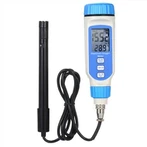The use of low voltage test pen
The low-voltage electroscope is mainly used to test whether the equipment is charged, in addition to testing:
1. Identify the phase line and the neutral line.
In the AC circuit, the wire that can make the neon tube glow after being touched by the electroscope is the phase wire, and the wire that does not shine is the zero wire. Except when the zero line is abnormal (such as the zero line is broken and the load is asymmetrical).
2. Determine the voltage level or whether there is leakage and induced voltage.
The voltage can be estimated according to the strength of the neon tube. The brighter the neon tube, the higher the voltage; the darker the neon tube, the lower the voltage (note: it is difficult to distinguish the light intensity of the neon tube in bright light).
For the 380/220V power supply system, if the neon tube is dark, it may be the leakage or induction of the equipment.
This method of discrimination can only be compared with the same electroscope. The neon tubes of different electroscopes have different starting voltages, which requires the tester to have certain experience in use.
The neon tube is bright, and it is suspected that the object is really charged or is leaking and induced electricity. Generally, you should not touch the object with your hands (even if you touch it, you should use the back of your hand, because if there is electricity, the muscles of the hand will contract and not touch it. electric shock by holding the conductor), but should be tested with a multimeter or a light bulb (the bulb voltage should be the same as the power supply voltage).
3. Distinguish between alternating current and direct current.
When measuring alternating current, the middle of the neon tube lights up; when measuring direct current, only one of the two poles of the neon tube lights up.
4. Identify the positive and negative ground faults of the DC system.
Generally, the DC systems of power stations and substations are insulated from the ground. If the neon tube lights up when tested with an electroscope, it means that the system has a grounding phenomenon (the grounding phenomenon cannot be detected when the grounding phenomenon is weak). If the bright spot is close to the tip of the pen, it means that the positive pole has a ground fault; if the bright spot is close to the end of the finger, it means that the negative pole has a ground fault.
Several conditions for the neon tube to emit light: ① the measured voltage is higher than the ignition voltage of the neon tube, the AC is about 50V, and the DC is about 90V; ② the current passing through the neon tube must be greater than a certain value, generally greater than 2μA (when the voltage is constant, It is determined by the resistance of a 1~3MΩ current limiting resistor inside the electroscope).






